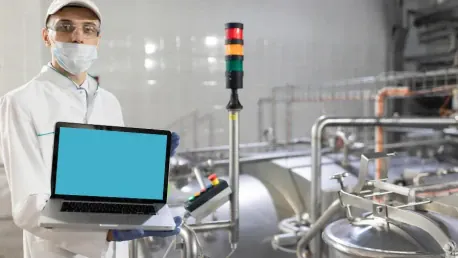In recent years, the food and beverage manufacturing sector has increasingly integrated operational technology (OT) systems, underscoring the paramount importance of robust cybersecurity measures. As the industry moves towards digital transformation, it must simultaneously grapple with escalating cyber threats. Ensuring the security of OT systems is not just about protecting data but also about safeguarding the entire operational workflow. Unsecured systems can lead to catastrophic impacts on production, safety, and compliance.
Understanding OT Vulnerabilities
Authentication and Authorization Deficiencies
One of the foremost vulnerabilities in the OT landscape is the gap in robust authentication and authorization protocols. Infosec’s report for 2024 highlights that inadequate measures to verify and authorize access pose a severe threat to OT systems. Without stringent controls, unauthorized personnel can gain access to sensitive systems, leading to severe consequences. This is akin to leaving the front door of a facility wide open, inviting intruders to walk in and compromise critical infrastructure.
To mitigate this risk, it is crucial for OT managers to implement multi-factor authentication (MFA) and role-based access control (RBAC). By doing so, they ensure that only authorized personnel can access specific systems and data, thus minimizing the chances of unauthorized breaches. Regular audits and reviews of access permissions are also essential to maintaining a secure environment. These steps are fundamental in reinforcing the digital front lines against potential cyber threats.
Exploitation of Weak Security Measures
Hackers are becoming increasingly sophisticated, often exploiting the path of least resistance to infiltrate OT systems. Rather than employing complex technical skills, they tend to capitalize on weak security protocols that are easily bypassed. This trend necessitates a proactive approach from IT and OT managers to identify and strengthen these weak points. The focus should be on regular vulnerability assessments and timely updates of security measures.
Implementing strong security policies and continuously educating staff about potential cyber threats are also vital. Employees need to be aware of phishing attacks, social engineering tactics, and other common hacking techniques. By fostering a culture of cybersecurity awareness, organizations can significantly reduce the risk of falling prey to hackers. The combination of robust technical defenses and educated personnel forms a formidable barrier against unauthorized access.
Best Practices for Enhancing OT Cybersecurity
Prioritizing Strong Authentication and Authorization
The foundation of any robust OT security framework is solid authentication and authorization controls. It starts with implementing multi-factor authentication (MFA) to add an extra layer of security beyond just passwords. MFA requires verified users to present multiple forms of identification before accessing critical systems. Additionally, role-based access control (RBAC) ensures that only individuals with the necessary permissions can reach sensitive areas of the network, thus sharply reducing the risk of internal breaches.
Periodic training sessions should also be held to keep all personnel informed about the latest security policies and potential threats. Ensuring that employees understand the importance of these measures and adhere to them can significantly curb unauthorized access. Moreover, integrating security into the core of operational processes makes it an intrinsic part of the daily workflow, simplifying compliance and fortifying defenses against possible intrusions.
Regularly Updating Security Protocols
The dynamic nature of cyber threats means that security protocols must continually evolve to counter new and emerging risks. Regular updates and patches for all OT systems are non-negotiable. These updates address vulnerabilities in the software, thus preventing exploitation by cybercriminals. It is equally essential to conduct frequent security audits and vulnerability assessments to identify potential weak points and rectify them promptly.
Employing advanced threat detection techniques, such as intrusion detection systems (IDS) and intrusion prevention systems (IPS), can provide real-time monitoring and alerts for suspicious activities. This enables swift action to neutralize threats before they can cause significant damage. By maintaining a proactive stance on cybersecurity, food and beverage manufacturers can effectively safeguard their OT systems against relentless cyber threats.
Future Considerations for OT Cybersecurity
Integrating Advanced Technologies
As cyber threats evolve, so too must the strategies to combat them. Integrating advanced technologies like artificial intelligence (AI) and machine learning (ML) can significantly enhance OT cybersecurity. AI and ML can analyze vast amounts of data to detect anomalies and patterns that may signify a potential cyber-attack. These technologies can provide predictive insights, enabling proactive measures rather than reactive responses.
Furthermore, the use of blockchain technology can ensure data integrity and security. Blockchain’s decentralized nature makes it highly resistant to tampering, making it an ideal solution for safeguarding sensitive information in OT systems. By investing in these advanced technologies, food and beverage manufacturers can stay ahead of the curve and build resilient defenses against sophisticated cyber threats.
Embracing a Holistic Security Strategy
A comprehensive approach to OT cybersecurity extends beyond just technical measures. It involves creating a culture of security awareness across the organization. Continuous education and training programs for employees, along with clear communication of cybersecurity policies, are essential components of this strategy. Encouraging employees to report suspicious activities without fear of repercussions can also help in early detection and prevention of potential threats.
Collaboration between IT and OT departments is crucial for a unified security front. Sharing insights and strategies between these teams ensures that all aspects of the security landscape are covered. Additionally, engaging with external cybersecurity experts can provide an objective evaluation of the current security posture and recommendations for improvements. By embracing a holistic security strategy, food and beverage manufacturers can ensure that their OT systems remain secure and resilient in the face of evolving cyber threats.
Moving Forward with Stronger Security
In recent years, the food and beverage manufacturing sector has increasingly incorporated operational technology (OT) systems, highlighting the critical need for strong cybersecurity measures. As the industry embraces digital transformation, it simultaneously faces escalating cyber threats. Ensuring the security of OT systems goes beyond merely protecting data; it also involves safeguarding the entire operational workflow. Failure to secure these systems can have disastrous consequences on production, safety, and regulatory compliance. A robust cybersecurity strategy is essential to prevent disruptions that could affect the supply chain, lead to financial losses, and damage brand reputation. Furthermore, OT system vulnerabilities can be exploited to cause machine malfunctions, endangering workers’ safety and leading to potential legal repercussions. Hence, the integration of advanced cybersecurity practices is imperative, not only to protect sensitive information but also to maintain the smooth and safe operation of manufacturing processes in the food and beverage industry.









